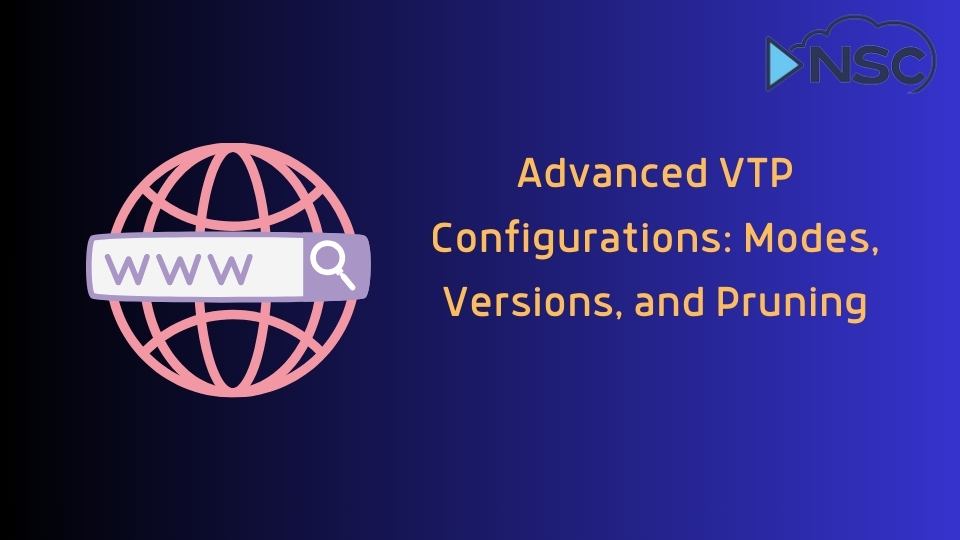In the realm of network management, understanding and effectively deploying VLAN Trunking Protocol (VTP) can significantly enhance operational efficiency.
This blogpost delves into the advanced configurations of VTP, exploring its various modes, versions, and the strategic use of VTP pruning.
We will navigate through the intricacies of configuring VTP modes, the steps for upgrading to different VTP versions, and the benefits of employing VTP pruning to optimize network performance. By mastering these advanced settings, network administrators can ensure seamless, scalable, and secure network operations.
VTP Modes
To efficiently manage VLANs across multiple switches, understanding VLAN Trunking and VTP is crucial. Our guide on VLAN Trunking and VTP Explained offers a clear breakdown of how these technologies work together to streamline network operations.
VTP operates in three distinct modes that facilitate the management and propagation of VLAN information across network devices. These modes are Server, Client, and Transparent. Each mode plays a critical role in how VLAN information is managed and disseminated throughout the network.
Configuring VTP Modes
To configure VTP modes, network administrators must access the switch’s configuration interface. Here's a brief outline of the steps involved:
- Server Mode: The default mode for most Cisco switches, responsible for creating, modifying, and deleting VLAN information that is then sent to all switches in the VTP domain.
- Client Mode: Cannot create, change, or delete VLANs but receives updates from VTP servers and forwards these to other switches.
- Transparent Mode: Does not participate in the VTP domain but still forwards VTP advertisements through connected trunk links.
Additionally, our Layer 2 Network Design course offers further exploration into efficient network structuring and management.

VTP Versions
VTP has evolved through several versions, each introducing new features and enhancements to improve VLAN management across network devices. The main versions are VTP version 1, VTP version 2, and VTP version 3. VTP version 3, the most advanced, supports enhanced authentication and extended VLAN environment capabilities, which are crucial for modern network demands.
Upgrading VTP Versions
Upgrading VTP versions involves several key steps to ensure that network integrity is maintained and that all devices are synchronized:
- Preparation: Verify the current VTP version and ensure all devices are compatible with the new version.
- Execution: Apply the upgrade commands on the VTP server, which will propagate the changes to all client switches in the domain.
- Verification: Check that all devices are correctly reporting the new version and that there are no synchronization issues.
VTP Pruning
Benefits of VTP Pruning
VTP pruning enhances network efficiency by limiting unnecessary flood traffic. By selectively pruning VLANs that are not needed on trunk links, it prevents the transmission of broadcast, multicast, and unicast traffic to switches that do not have ports in those VLANs. This strategic approach reduces unnecessary load and improves overall network performance, crucial for maintaining a streamlined network infrastructure.
Implementing VTP Pruning
Implementing VTP pruning involves several crucial steps:
- Enable Pruning on the VTP Server: Activating pruning at the server level ensures that it is propagated across the domain, optimizing traffic flow across all connected devices.
- Verify Pruning Status on Switches: Regular checks to confirm that switches are correctly applying pruning settings are vital for consistent network performance.
For network professionals looking to enhance their expertise in network protocol configurations, including advanced VTP settings, our Self-paced CCNP ENARSI Training provides comprehensive insights.
Summary
In conclusion, mastering advanced VTP configurations such as modes, versions, and pruning is essential for optimizing network performance.
Understanding and implementing VTP modes enhances control over VLAN information across networks, while upgrading to VTP version 3 brings improved security and handling of extended VLANs. Furthermore, VTP pruning plays a crucial role in reducing unnecessary network traffic, ensuring efficient data flow and network stability.
By adopting these advanced strategies, network administrators can ensure their networks are both powerful and scalable. For further learning, our specialized courses provide in-depth training and practical applications in network design and management.


